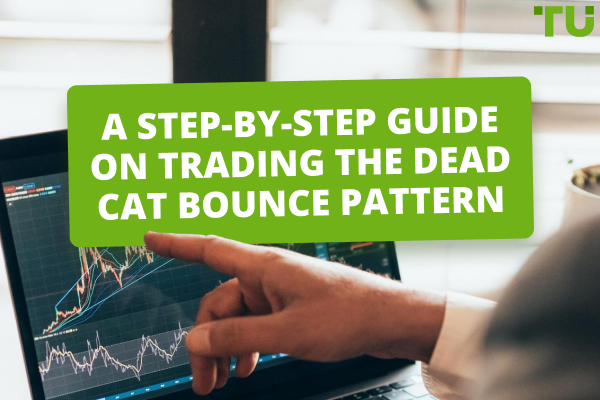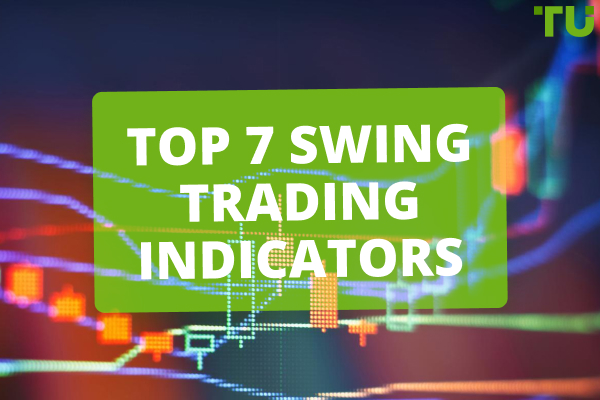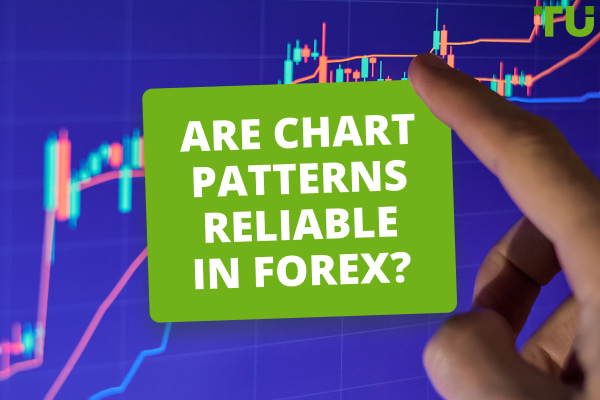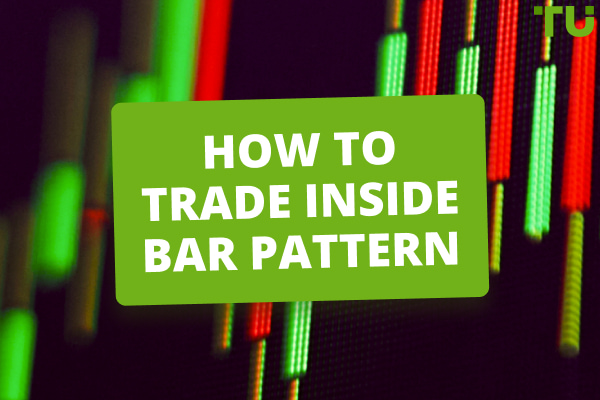Leveraging the W Pattern in Your Trading Strategy
The W Pattern, a technical trading indicator, signals a bullish market reversal. It's characterized by two troughs at roughly the same low level, separated by a peak.
-
Features: Bullish reversal indicator; Double-bottom structure.
-
Pros: Clear entry, stop-loss, and target points. Applicable to various assets.
-
Cons: Possibility of false signals. Subjective. Dependent on market conditions.
Chart patterns allow traders to structure price dynamics and systematize their trading decisions. One of the main patterns for them is the W pattern.
This comprehensive guide aims to illuminate the path for beginners, unraveling the complexities of the W pattern. Through a meticulous exploration of its basics, application, and nuanced strategies, we equip traders with the knowledge to harness this pattern's potential, enhancing their trading acumen and decision-making prowess.
-
What is a W pattern in trading?
A W pattern in trading is a chart formation that suggests a reversal from a downward trend to an upward trend.
-
What Is a Double Bottom?
A Double Bottom, another name for the W pattern, is a bullish chart pattern that resembles the letter W and indicates a potential reversal of a downward trend.
-
Is the W pattern bullish or bearish?
The W pattern is considered bullish, signaling a potential shift from a downtrend to an uptrend. A inverseW pattern can be considered a bearish formation.
-
Is pattern trading effective?
Pattern trading can be effective when combined with other technical analysis tools and proper risk management strategies.
W Pattern Basics
The W pattern, often hailed as the harbinger of bullish reversals, unfolds on the charts as a double bottom, sketching a tale of resilience and impending uptrend. Identifying this pattern requires a keen eye on price action, where the market, after a downturn, attempts to recover, fails, and dips again only to bounce back with vigor, sketching a “W” on the chart. This visual cue is your first step towards mastering the W pattern.
Diversity marks its presence even in patterns. The W pattern is no exception, manifesting in various forms—ranging from the classic W to more complex iterations like the double bottom with a lower second bottom. Each type has its nuances and implications, making the understanding of their distinctions critical for accurate interpretation and application.
Interpretation is the key that unlocks the potential of the W pattern. It signals not just a potential end to a downtrend but also the strength of a forthcoming uptrend. The pattern’s completion—when the price breaks through the resistance formed at the top of the W—heralds a bullish reversal, suggesting an opportune moment for traders to consider entering the market.
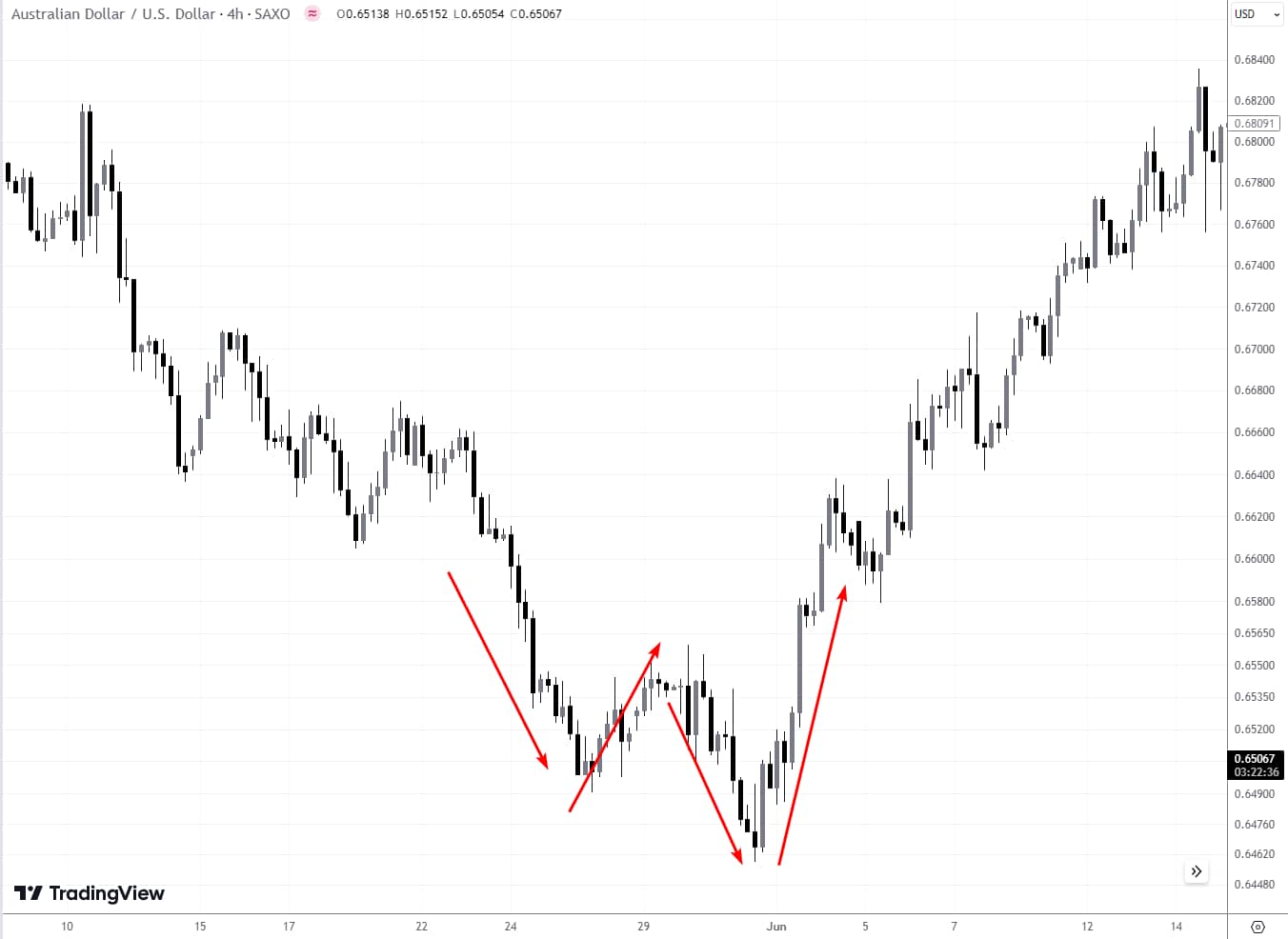
W pattern with a lower second bottom
To illustrate, let’s look at the above image. We can see a crisp, clear W pattern, annotated to highlight the initial dip, the interim peak, the second dip, and the eventual breakout. This visual aid, complemented by annotations, demystifies the pattern, making the theoretical tangible and the complex simple.
In the above case, the W pattern causes the downtrend to change to an uptrend. Moreover, the lower second bottom makes it difficult for traders to enter a long position, activating stop losses set under the first bottom.
This section lays the foundation, offering a lens through which traders can view and decipher the W pattern. With this understanding, the journey from recognizing to effectively trading the W pattern begins, opening up a world of opportunities for those ready to learn and apply.
Best Forex brokers


How do you use W patterns?
Trading with the W pattern hinges on precise execution:
-
recognizing the confirmation signal;
-
placing a strategic stop-loss;
-
and calculating the target.
In terms of classical technical analysis, the confirmation signal occurs when the price breaks above the resistance level at the peak of the W, indicating a potential bullish reversal. Traders are usually advised to wait for a conclusive breakout above this resistance before entering a trade to avoid false signals.
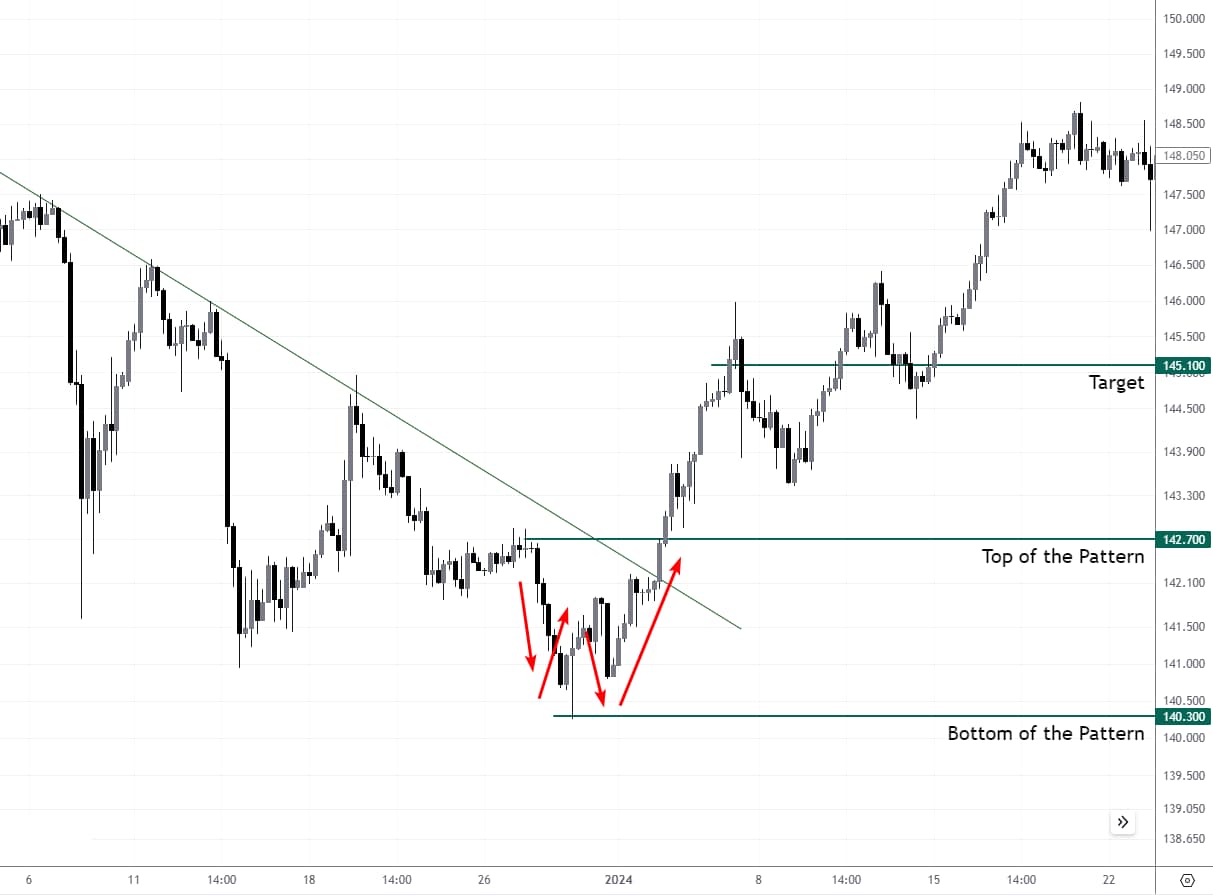
W pattern on the USD/JPY chart
However, the chart above shows an example when traders get a reason to enter a long position after breaking the downtrend line without waiting for the top of the pattern to break.
To calculate the target, measure the distance from the bottom of the lowest trough to the resistance level and project this same distance upwards from the breakout point. This projection helps in setting a realistic profit-taking level, aiming to capture the upward momentum post-confirmation.
Studying numerous examples of the W pattern on various charts and can significantly improve trading outcomes when dealing with W patterns.
What is the stop loss in the W pattern?
There are two approaches: conservative and non-traditional.
In the traditional approach, the stop loss is set below the low of the W pattern. This is simple, but worsens the risk-to-potential reward ratio. Should the market price fall below this trough, it suggests that the expected upward trend may not materialize, and thus, exiting the trade at this point helps minimize losses.
In a non-traditional approach, traders can use other methods:
-
set stop losses using the lows on the lower timeframes;
-
set stop losses using indicators;
-
use a formula - for example, set a stop loss so that the reward to risk ratio is 2:1.
Remember, the stop-loss strategy is fundamental in managing risk, ensuring traders are shielded from larger-than-expected downturns.
Example 1: W Pattern in Stocks
The stock chart for Microsoft (MSFT) highlights a W pattern indicative of potential bullish reversal after a decline from the $275 per share MSFT level. The price exhibits a notable decline to form the first trough, rises to a peak, dips to create a second trough, and ultimately ascends past the initial peak, signaling the pattern's completion and a shift to an upward trend.
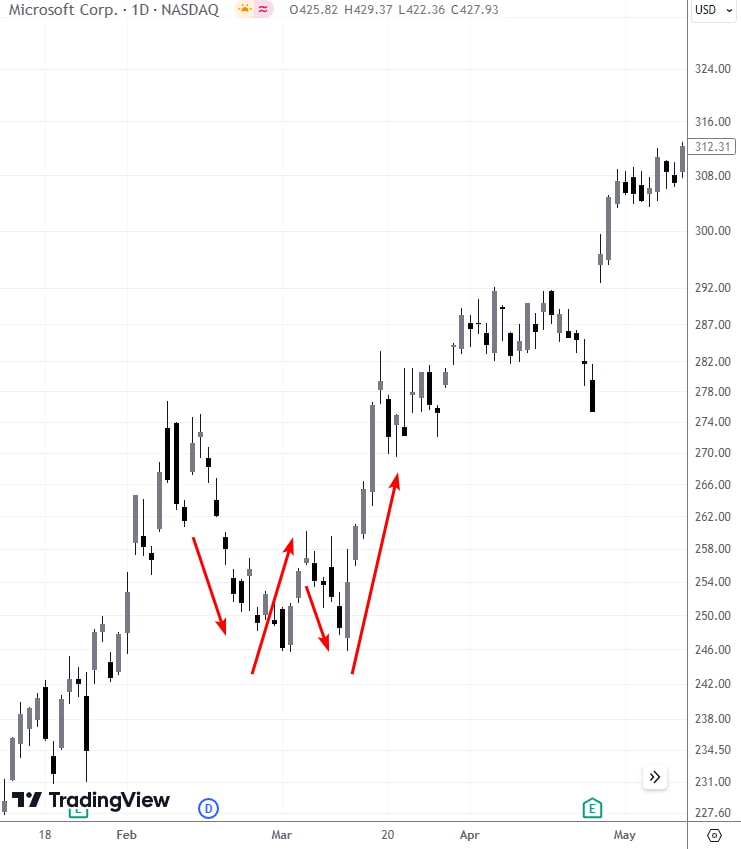
Microsoft (MSFT) Chart showing a W pattern
W pattern can be interpreted in such a way that the market by its action indicated the shortage of those willing to sell the stock below the psychological mark of 250 dollars.
-
Traders eye the breakout point above the pattern's peak (around $260) as a cue to initiate a long position.
-
If no other methods are used, a stop loss can be set below $250, safeguarding against false reversals.
-
The aim for profit is typically gauged by the depth of the W, projected above the resistance line broken by the breakout. At the same time, investors may retain all or part of their positions in anticipation of the long-term potential of the blue chip.
Example 2: W Pattern in Crypto
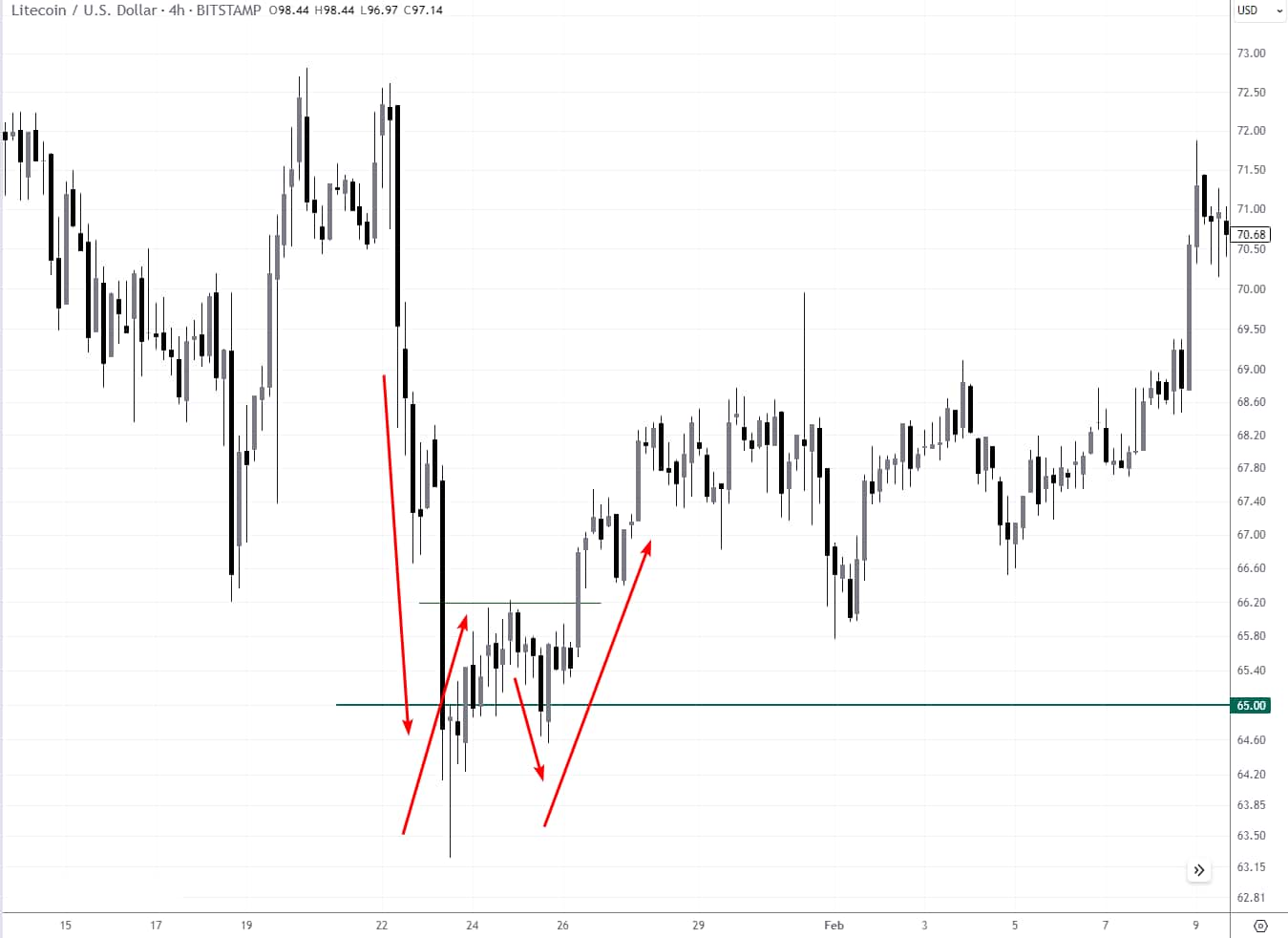
Litecoin/USD chart showing a W pattern
The Litecoin to U.S. Dollar chart on a 4-hour timeframe from Bitstamp illustrates an interesting W pattern to consider.
-
The pattern is drawn on the chart when the price of the coin falls below the $65 level, forming the first trough, which has the characteristic of panic.
-
An intermediate top is then formed around $66.20.
-
The price then drops to form a second trough. But the sellers' pressure is small, so the second trough is above the first one implying that the panic has subsided and traders may consider the idea of long entry when the price will break through the resistance level of the intermediate peak.
The target for profit-taking is usually determined by the vertical distance from the troughs to the peak, projected above the breakout point. Trading the W pattern in the crypto market, as shown here, involves careful monitoring of price movements for a robust entry and exit strategy.
Example 3: W Pattern in Forex
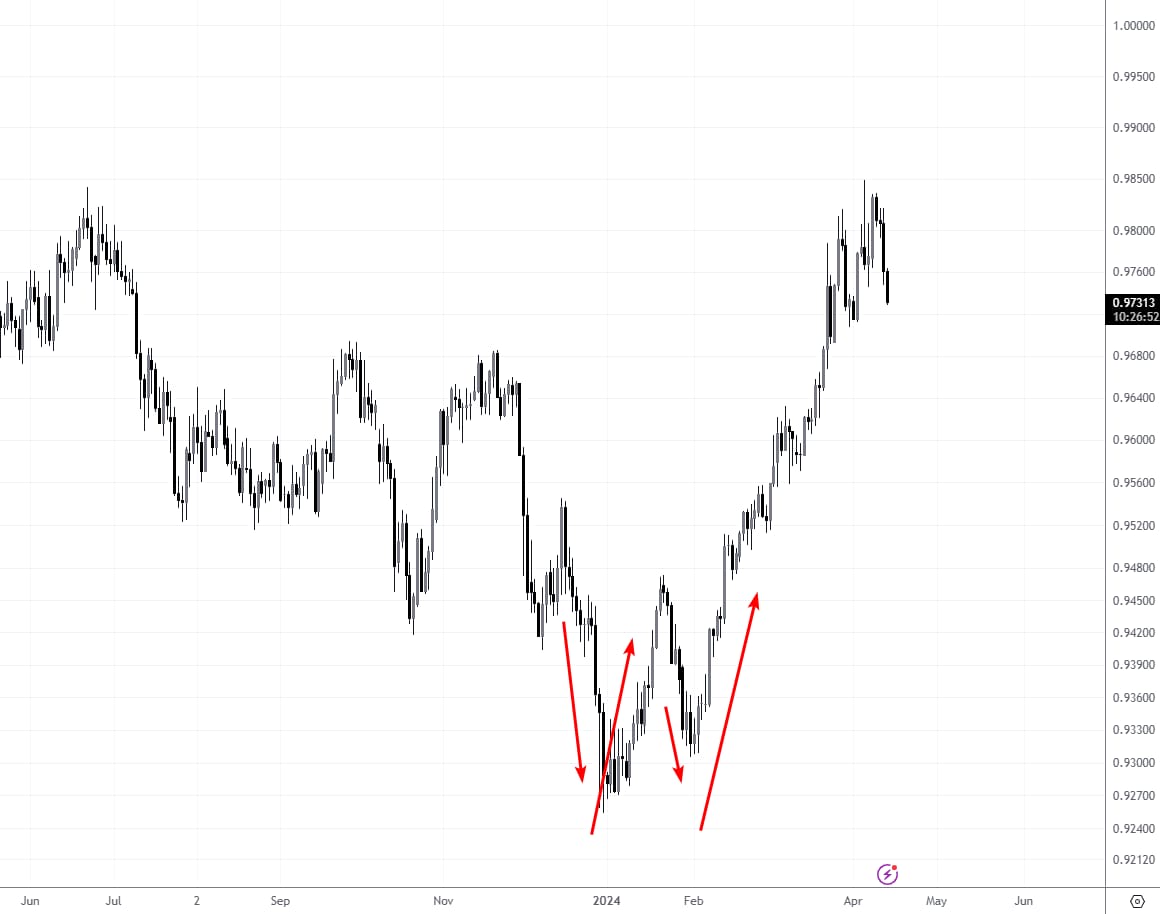
EUR/CHF chart showing a W pattern
In this Forex example, we observe the EUR/CHF on a daily chart, where a W pattern took shape. This pattern is characterized by a drop in price that forms the first trough below 0.930, an ascent to a peak, followed by a second drop, and a rebound that aims to surpass the peak level.
On the right side of the chart, we see positive price action following the W pattern. A trader watching this pattern develop would prepare for a potential bullish reversal upon the price breaking above the resistance at the peak of the W.
In trading this pattern, a stop-loss would be judiciously placed below the second trough to minimize risk in case of a reversal failure. If the pattern were to complete successfully, the trader would set a profit target based on the height of the W, replicated above the breakout point. This image serves as a practical example of how a W pattern might present itself in Forex trading, with the added caveat of recognizing potential failures and managing risk accordingly.
Should I Trade W Pattern?
The W pattern, recognized for its double bottom, often signifies a potential shift from a bearish to bullish market sentiment and serves as a strategic tool for traders across various asset classes. However, whether to incorporate this pattern into your trading strategy requires careful consideration of its context, potential risk, and alignment with your trading goals.
The pattern’s effectiveness can vary depending on market conditions, volume, and the trader's experience in pattern recognition. Traders often use it in combination with other technical indicators to validate signals.
Benefits of Using W Pattern
-
Clear Entry and Exit Points: The breakout and troughs provide explicit signals for trade entry and stop-loss placements.
-
Risk Management: Well-defined stop-loss levels help limit potential losses.
-
Predictable Targets: The height of the pattern allows for straightforward profit target calculations.
-
Frequent Occurrences: The pattern appears often enough across markets, providing numerous trading opportunities.
-
Versatility: Applicable in stocks, Forex, and crypto trading with equal relevance.
Why Not to Trade W Pattern
-
False Signals: The pattern can produce false breakouts leading to losses.
-
Context-Dependent: It requires confirmation with other indicators, as it may not be reliable on its own. Accurate identification often requires considerable experience and skill.
-
Market Volatility: Can be less effective during high volatility, leading to misinterpretation.
-
Low R:R Ratio: Requiring an improvement in the ratio of risk to potential benefit.
-
Delayed Entry: Waiting for pattern completion may lead to missing early movement gains.
Expert Tip
Trading the W pattern is like surfing - you must catch the wave at the right moment. Patience is key, wait for the full formation and a confirmed breakout to ensure you're riding a wave, not caught in a ripple.
Traders must approach the W pattern with patience, discipline, and an awareness of the risks, such as false breakouts and the necessity of experience for accurate pattern identification. Incorporating this pattern into a broader, well-considered trading strategy can be a powerful asset for any trader's arsenal. I recommend using the W pattern together with other indicators. This will allow you to avoid incorrect determination of trends and false breakthroughs.
Team that worked on the article
Vuk stands at the forefront of financial journalism, blending over six years of crypto investing experience with profound insights gained from navigating two bull/bear cycles. A dedicated content writer, Vuk has contributed to a myriad of publications and projects. His journey from an English language graduate to a sought-after voice in finance reflects his passion for demystifying complex financial concepts, making him a helpful guide for both newcomers and seasoned investors.
Dr. BJ Johnson is a PhD in English Language and an editor with over 15 years of experience. He earned his degree in English Language in the U.S and the UK. In 2020, Dr. Johnson joined the Traders Union team. Since then, he has created over 100 exclusive articles and edited over 300 articles of other authors.
Mirjan Hipolito is a journalist and news editor at Traders Union. She is an expert crypto writer with five years of experience in the financial markets. Her specialties are daily market news, price predictions, and Initial Coin Offerings (ICO).



